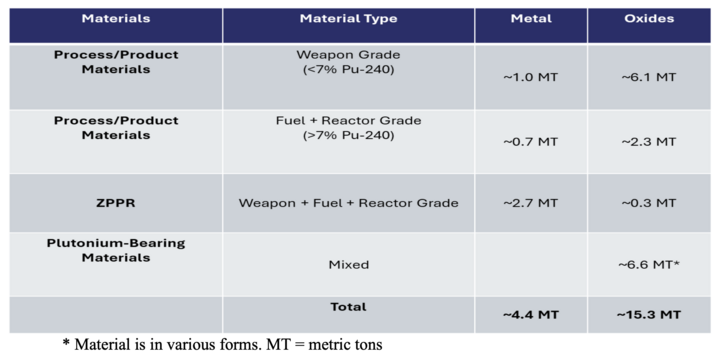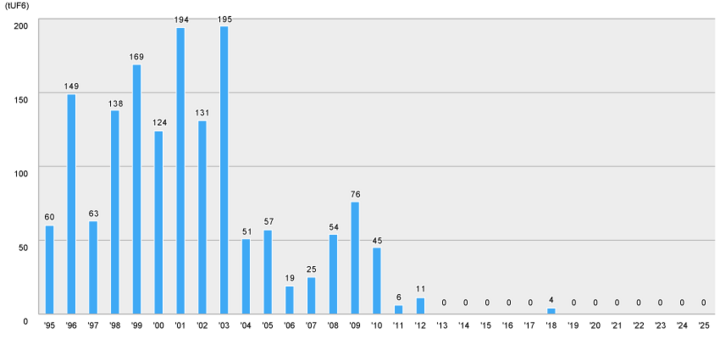On 18 December 2025, the US Nuclear Regulatory Commission issued a license XSNM3854, which allows Mirion Technologies, a US company, to export "0.00462 kg of HEU, enriched to up to 93%, containing 0.00432 kg of uranium-235." The material is contained in six assemblies that will be used for monitoring of thermal neutron flux radiation in Kijang research reactor.
The United Kingdom's Nuclear Decommissioning Authority (NDA) has successfully converted "a can of plutonium residue" into a stable waste form suitable for disposition. This step is part of the program that aims to process "around 400 cans of plutonium residue" stored at the NDA group's Sellafield site. According to the Sellafield CEO, this particular step means that the UK is able to "deal with some of the more problematic plutonium."
The United Kingdom has the largest stock of civilian plutonium, 116.8 tonnes as of the end of 2023 (in addition, there is 21.7 tonnes of Japan's plutonium stored in the UK). In January 2025, the UK government made a decision to immobilize UK-owned plutonium. In August 2025, the government allocated £154 million toward this program.
The United Kingdom is reportedly exploring two immobilization options - Disposal MOX and Hot Isostatic Pressing. Both processes create ceramic material suitable for disposal.
For a discussion of the storage MOX option, see this article:
J. Kang, F. N. von Hippel, A. Macfarlane, R. Nelson, "Storage MOX: A Third Way for Plutonium Disposal?," Science & Global Security, 10, no. 2, (2002): 85-101.
The Siberian Chemical Combine in Seversk became the third Russian enrichment plant that began deployment of centrifuges of the 9+ generation. The program is expected to be completed in 2027.
The first enrichment plant to undergo modernization was the Electrochemical Plant in Zelenogorsk (the installation of new centrifuges began in 2019 and was completed in 2025). The installation of generation 9+ centrifuges at the Urals Electrochemical Combine in Novouralsk began in 2018. According to the TVEL report, the generation 9+ centrifuges will be installed at the Angarsk Electrolysis Chemical Combine as well.
Russia is also working on what was described as 10th-generation centrifuges.
According to the fact sheet released by the White House, at the 29 October 2025 summit meeting the presidents of the United States and the Republic of Korea reached an agreement that will support the development of nuclear fuel cycle technologies as well as that of naval nuclear reactors in South Korea.
The fact sheet states:
Consistent with the bilateral 123 agreement and subject to U.S. legal requirements, the United States supports the process that will lead to the ROK's civil uranium enrichment and spent fuel reprocessing for peaceful uses.
The United States has given approval for the ROK to build nuclear-powered attack submarines. The United States will work closely with the ROK to advance requirements for this shipbuilding project, including avenues to source fuel.
The 123 agreement between the United States and the Republic of Korea, concluded in 2015 and expected to remain in force until 2040, does not prohibit the development of enrichment or reprocessing. However, it imposes restrictions on the use of materials or technologies supplied by the United States under this cooperation agreement.
The clause that deals with nuclear-powered submarines does not seem to commit the United States to a transfer of technology or material. Importantly, the current agreement explicitly prohibits enriching US-origin uranium to more than 20% uranium-235.
The President of Russia signed a federal law that formally ended Russia's participation in the US-Russian Plutonium Management and Disposition Agreement (PMDA). The law denounces the agreement, signed on 29 August 2000 in Moscow and on 1 September 2000 in Washington, and the protocols to the agreement, signed on 15 September 2006 and on 13 April 2010.
The agreement, as amended by a protocol in 2010, committed the United States and Russia each to eliminate 34 tonnes of plutonium "designated as no longer required for defense purposes."
Russia suspended the implementation of the agreement in October 2016, citing "unfriendly actions of the United States." To a large extent the suspension was a result of a dispute about the United States unilaterally changing its plutonium disposition method (see also earlier IPFM analysis as well as this article).
It is worth noting that while Russia ratified PMDA in 2011, the agreement has never been in force. The Federal Law No. 108-FZ on the ratification of PMDA was signed by the then-President Medvedev on 3 June 2011. The law would have entered into force ten days after its official publication on the pravo.gov.ru portal. However, it has never been officially published and therefore the agreement has never entered into force. For this reason, the current law denounces the agreement and its protocols directly rather than denouncing the 2011 law that ratified it.
In 2016, Russia's participation in the PMDA was suspended by a presidential decree (which also did not mention the fact of ratification in 2011). In it, President Putin decreed:
To establish that plutonium covered by the [PMDA] Agreement [...] shall not be used for the purposes of manufacturing nuclear weapons or other nuclear explosive devices, for research, development, design, or testing related to such devices, or for any other military purposes.
The legal status of this obligation is not clear but it appears to remain in force unless a subsequent presidential decree revokes it. The Federal Law No. 381-FZ from 31 October 2016, which was passed to codify the suspension, does not contain this clause. The law on the denunciation of PMDA does not revoke or even mention the 2016 decree, so it appears that the obligation not to use the PMDA material for military purposes continues to apply.
On 21 October 2025, the US Department of Energy issued a Request for Applications DE-FOA-0003594 as part of "a program for making surplus plutonium materials available to industry for advanced nuclear technologies."
The program was established by the May 2025 executive order that also terminated the previously selected disposition route, the dilute and dispose program. That program was authorized in 2016 and sent the first material to WIPP in 2022. It should be noted that the DoE does not exclude the possibility of returning some of the material allocated to the current program to the dilute and dispose route.
The total amount of plutonium that is offered to industry is 19.7 metric tons (MT). Of this, 15.3 MT is in oxide form and 4.4 MT is in the metal form. About 7.1 MT of this is weapon-grade plutonium (about 1 MT is in metal form). The full breakdown by categories is in the table below. An earlier report by Politico suggested that the DoE is prepared to make available up to 25 MT of plutonium.
According to ANS, there are at least four companies that expressed interest in using plutonium: Curio, Lightbridge, Newcleo, and Oklo.
The uranium enrichment plant in Rokkasho, operated by Japan Nuclear Fuel Ltd, has received a shipment of natural uranium from Cameco, a Canadian company. The shipment included "up to 625 tons of uranium contained in 50 cylinders" (50 48Y cylinders).
This is the first shipment of uranium to Rokkasho since July 2014. As shown in the chart, reproduced from the JNFL site, the plant has shipped virtually no enriched uranium after 2012.
It is not clear if the plant has been producing enriched uranium during this period. According to an industry report, the plant suspended operations in 2017, but resumed them in August 2023.
It was estimated that in 2019, the plant had the capacity of 75 tSWU/year. The current capacity of the plant is reported to be 112.5 tSWU/year. The same report says that JNFL aims to expand capacity to 450 tons SWU/year by FY2028. This plan appears to include the upgrade of the No. 2 cascade facility with the capacity of 150 tSWU/year.
The JNFL plans to eventually bring the capacity of the plant to 1,500 tSWU/year.
US National Nuclear Security Administration (NNSA) awarded a contract, currently valued at $1.5 billion, to BWXT Enrichment Operations, LLC "for the licensing, manufacturing development, facility construction, and operations of a Domestic Uranium Enrichment Centrifuge Experiment (DUECE) pilot plant."
The plant is part of the effort to establish the supply of unobligated enriched uranium that can be used for defense purposes: LEU for tritium production and HEU for naval nuclear propulsion.
In 2024, NNSA asked Nuclear Fuel Services, a subsidiary of BWXT, to conduct a study of domestic enrichment options.
According to Orano, the 9th shipment of MOX fuel from France to Japan has left France on 6 September 2025 and is expected to arrive in Japan in November 2025. The ships that transfer the fuel are "Pacific Heron and Pacific Egret, the specialized ships belonging to British company PNTL."
The 8th shipment was completed in September 2022.
UPDATE: The ships arrived in Japan on 17 November 2025.
UK Nuclear Decommissioning Authority (NDA) has been allocated £154 million in government funding to begin preparatory work for the plutonium disposal program.
The decision to immobilize UK-owned separated plutonium was announced in January 2025.

